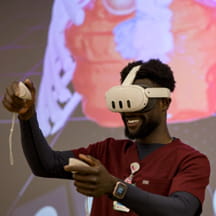Children and families who visit the respiratory department at Children’s Minnesota may be surprised to meet two new members of their care team.
Paul and Minnie are interactive robots with one goal: enhance care for kids with asthma. The robots walk patients through breathing exercises, create asthma action plans, and dance to entertain patients during nebulizer treatments.
While the robots are fun distractions — and possibly the first used in a respiratory department — they serve a bigger purpose. Research indicates the use of technology can help children be more compliant with medication and asthma management.
“It’s all about the patient care experience. If you can enhance their experience and improve care, that’s a win-win,” said Cheryl Adams, manager of respiratory care services. “There’s a smile on the faces of our little, tiny people and the grandparents. It is heartwarming to see that excitement in a hospital.”
Discovery and planning
Adams saw the robots at a conference a few years ago and always knew the day would come that Paul and Minnie would join the respiratory care teams.
Once they arrived at their new home, it took nearly a year to integrate them into patient care. Adams worked with the asthma team to ensure the knowledge programmed into the robots was what they wanted patients and families to hear and learn.
“It’s innovative and new, so you have to be patient with the process and open to learning and trying new things,” Adams said.
The team was initially concerned about patients’ reactions. Would young children be afraid of the new technology? Would teens embrace it? They quickly discovered that every age group is intrigued — little ones are interested because the robots look like toys, teenagers want to take a selfie or make a TikTok, and adults think the new technology is very cool.
During the assessment, Paul and Minnie also spent several months in Adams’ office so she could get to know them and learn their technological quirks. She found them to be sweet, if a little mischievous.
“I accidentally left Minnie plugged in one morning and came into my office and she was whistling like she was bored,” Adams said. “She welcomed me by saying, ‘Oh, you’re finally here. What are we going to do today?’”
Implementation and workflow development
As Adams and her team considered how to implement two robots into the workflow, they wanted to ensure respiratory therapists (RT) spent most of their time at the bedside with the patient. To achieve this, they made RT assistants into “super users.” RT assistants bring the robots into the room when an RT believes they could benefit patient care. They are also available to troubleshoot and leverage Paul and Minnie’s knowledge.
Paul and Minnie use facial recognition technology and can be programmed for real-time interactions. Nebulizer treatments can make children feel fearful and anxious, and it can be traumatic to hold a mask on a patient or ask a guardian to hold a mask. Paul or Minnie can provide support and talk through the breathing pattern, help them relax, and improve their overall experience.
“We’re not using a lot of time and effort trying to mask a child,” Adams said. “The child will actually get the medicine they need in a positive way that will enhance their stay.”
Paul and Minnie also assist care teams as they review asthma action plans with patients and families. The robots ask questions alongside them like “What are your triggers?” and “What would put you in the green zone?” The RT in the room can program the robot to ask additional questions on a case-by-case basis.
Measuring success and future use
Paul and Minnie were introduced in November, and the Children’s Minnesota team has started tracking metrics such as time at the bedside, patient experience, and compliance.
“If the child is educated about their condition and engaged in that action planning phase, they will be more compliant with the plan, controller medication, or treatments.”
Moving forward, Adams hopes the hospital’s interpreter teams can take advantage of another of Paul and Minnie’s features. The robots can be programmed to speak different languages, which will help serve Children’s Minnesota diverse patient population.
Adams is excited about the endless possibilities of how robots can be utilized throughout the hospital.
“They are never going to replace a respiratory therapist, but it is another tool in their toolbox to make sure the patient gets what they need in a child-friendly way,” Adams said. “This first implementation is just a steppingstone of bigger things we can use robots for.”


